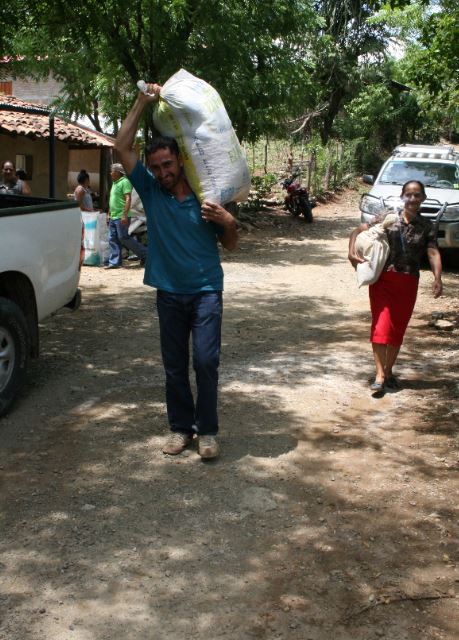It just so happens that this question of scarcity has been on my mind a lot recently. Since we arrived in Nicaragua, one of the first issues we needed to think about was the severe drought that was being experienced throughout Central America's dry corridor. These are considered effects of climate change and the El Niño phenomenon.

MCC partners with an organization, called ADENOCH (Asociación para el Desarrollo del Norte de Chinandega) within this area, working with conservation agriculture (I showed some pictures of this back in July). Unfortunately, not much will grow without any rain, even with conservation agriculture methods. The first planting did not yield a harvest, which left farmers without seeds for the second planting. MCC worked together with the Canadian Foodgrains Bank in a relief project to distribute seed and food to families in most need throughout the communities where ADENOCH works.
I'm still just learning about the Canadian Foodgrains Bank, but it is a great program and MCC has been closely involved with them since their beginning. I understand that one of the ways that funds come into this program is through Canadian farmers who donate their crop to CFGB, who sells it and then uses those funds around the world. It used to be that they would send the grain itself; today it is more cost-effective to procure grains, food, etc, closer to the population in need.
This past week, ADENOCH rushed to get seeds out in time for the second planting. On Saturday, I made a trip up to the area to see how the food distribution is going. Here's a map so you can see more or less where I'm talking about.
This particular path passes by a row of volcanos. Here's the last one I passed, San Cristobal, the tallest in the country at 5,275 ft and remains active coughing dust now and then.
When I arrived, the director of ADENOCH, Elder, briefed me on what was going on. We were in a community called Los Pozos, where the people who had been invited had gathered for the distribution. An ADENOCH board member would open with a prayer, Elder would speak, and then I was supposed to speak. Oh, ok, the impromptu speech. I told about the farmers who give to CFGB and the story of Jesus feeding the 5,000 that we happened to read with the kids the other day. Realizing that there are many more people in the dry corridor than what we were serving through this project, I mentioned that this feels in someways like 5 loaves and 2 fish. May God bless the seed and the food for these families and beyond.
(Alison Franceli Cali Vallecío, Claydis Junieth Vallecio Mejía, Franscica Vallecio Ochoa)
(Gunner José Aguilera Martinez, Lucía Olga Martinez Espinal)
From there, we continued to another community called Las Lajitas for the same routine. I appreciated the Toyota Hilux power on these roads. I'm not sure this picture captures the scale of some of these inclines/declines, but it's what I got.
(Gerardo, ADENOCH board member)
Once again, people were grateful and it was humbling to be in a position to be able to connect people and resources.
Some happy kids playing baseball.
From there, I went to join the ADENOCH staff that were present for lunch and then met with Elder back at his office for a while to talk through details about how the rest of the distribution would be happening, how the follow-up happens, etc.
The night before I traveled up the area had received a tremendous rain, the most significant rainfall they have had since June. I hadn't traveled far before another thunderstorm opened up. It was a great moment (even though it becomes exhausting to drive with rain, dusk/night, horses and cattle crossing the street, major potholes to avoid, people walking or biking beside the road, etc.). I called Elder back in Managua and asked if he had gotten the rain. Unfortunately, this one was just south of them, and some of their communities would have gotten the rain, but where he was, very little fell. We'll keep them in prayer for the next one.












Oremos por la lluvia.
ReplyDelete